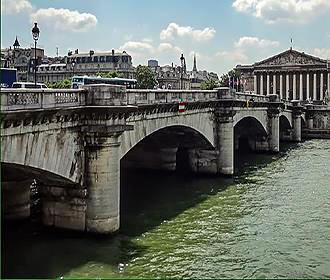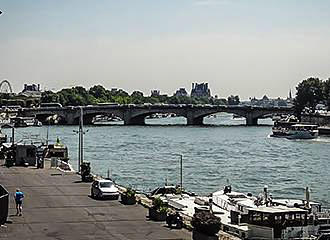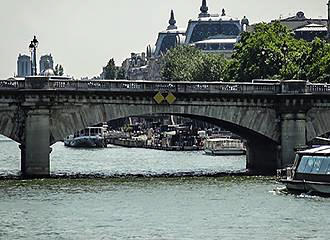Paris Pont de la Concorde Bridge in France
The Paris Pont de la Concorde bridge in France that has been crossing over the River Seine since the 1700s, and although it has changed over the years, including its name, it is now classified as one of the historical monuments in Paris.
Pont de la Concorde bridge history
There was once a ferry that used to be in place to get people across from the Palais Bourbon to the Tuileries Palace, and a new bridge was planned in order to replace this ferry service when the Paris square called the Place Louis XV was being constructed.
And although it had been planned since 1755, this bridge over the River Seine was only eventually commissioned in 1787 and the design was left in the capable hands of the architect Jean-Rodolphe Perronet.
Work started, but then came the French Revolution and the storming of the Bastille on 14th July 1789, yet this was not a complete disaster, because some of the dimension stones and dressed stone from the demolished Bastille prison were used to build sections of the new bridge.
Eventually the bridge was completed in 1791 and named the Pont Louis XVI, then it changed to the Pont de la Revolution, and then to the Paris Pont de la Concorde bridge during the reign of Napoleon Bonaparte I, who also had eight figures of generals that had died in battles placed on the bridge in 1810.
However, during the Bourbon Restoration in 1814, this bridge in Paris reverted back to the original name of Pont Louis XVI and the statues of generals from the Empire were removed and replaced with twelve whitel marble monumental statues including those of ministers such as Colbert and Richelieu.
Yet by 1830 this historical bridge over the River Seine had its name changed yet again, and this time it was back to the Paris Pont de la Concorde bridge in France, which has remained the same every since, but the marble statues were found to be too heavy for the bridge, and they were removed and taken to Chateau Versailles.
About the Paris Pont de la Concorde Bridge in France
Not much changed with the bridge that has five stone arches spanning the River Seine, with the middle arch being the largest at approximately 31 metres. But due to a massive increase in traffic over the years, it was decided that the Paris Pont de la Concorde bridge in France would have to be widened, which took place between 1930 and 1931, yet this was very cleverly done in order to retain the original shape of the bridge, and this is what you will get to see today.
And although the Paris Pont de la Concorde bridge in France is always busy with traffic, sometimes even being compared to that of the Peripherie around Paris, there are wide paths either side, making walking across safe and easy. This also means you can get a fabulous view towards either the Palais Bourbon, which is home to the National Assembly, or to the Paris Place de la Concorde, which is the large Paris square with its ornate fountains and large statues representing different cities in France.
Visiting the Paris Pont de la Concorde Bridge in France
You will find the Paris Pont de la Concorde bridge in France located between the Qua d’Orsay on the left bank by the Palais Bourbon and the Quai des Tuileries on the right bank of the River Seine by the Place de la Concorde, which is home to the Luxor Obelisk, and the next bridge downstream is the ornate Pont Alexandre III.
Now when it comes to using Paris public transport you could utilise the Metro and the Concorde stop via lines 1, 8 or 12, or alternatively you have the Invalides stop via lines 8 or 13 on the Metro, or line C if you are travelling on the RER trains. However, there is also a Batobus water bus stop located close by, and you will find that many of the bus tours like Paris Tootbus tours also stop nearby as well.


